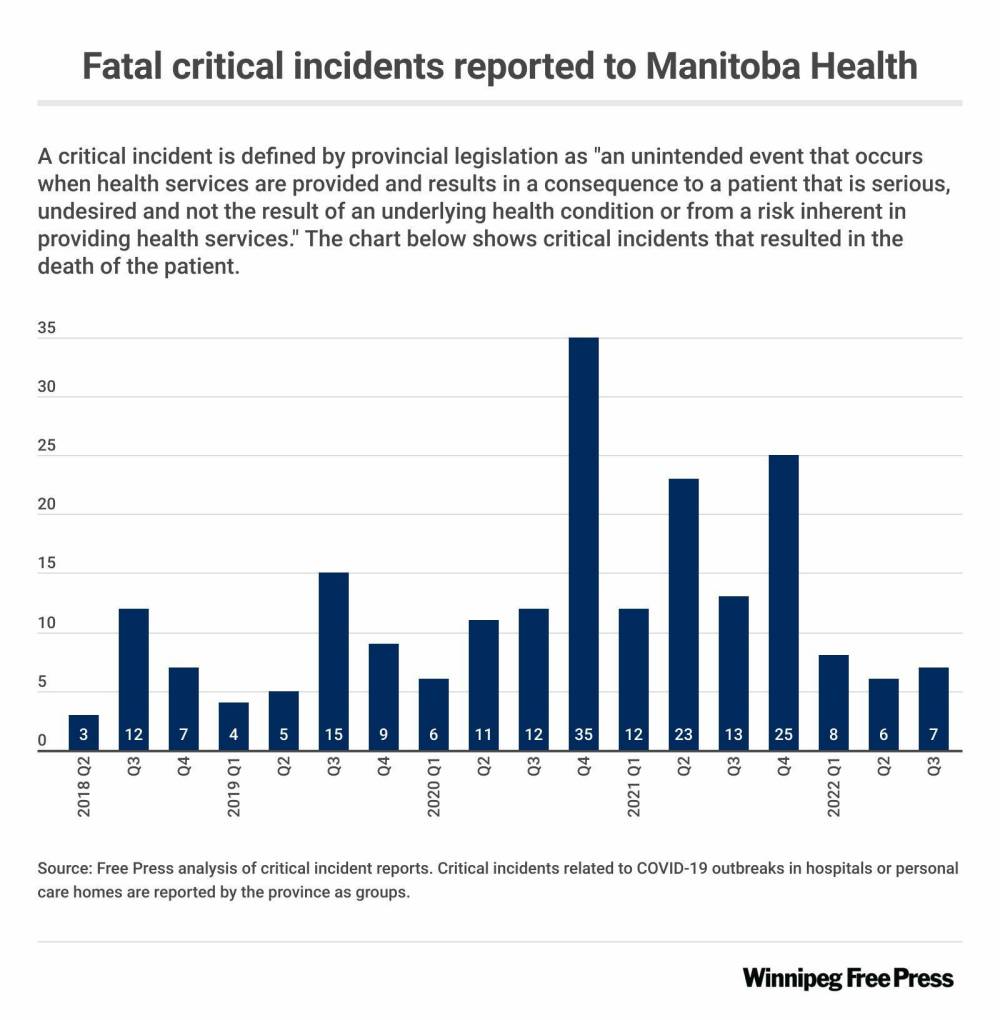Grace ER death in November ruled critical incident Lack of public information on patient care raises transparency alarm bells inside health system
Read this article for free:
or
Already have an account? Log in here »
To continue reading, please subscribe:
Monthly Digital Subscription
$0 for the first 4 weeks*
- Enjoy unlimited reading on winnipegfreepress.com
- Read the E-Edition, our digital replica newspaper
- Access News Break, our award-winning app
- Play interactive puzzles
*No charge for 4 weeks then price increases to the regular rate of $19.00 plus GST every four weeks. Offer available to new and qualified returning subscribers only. Cancel any time.
Monthly Digital Subscription
$4.75/week*
- Enjoy unlimited reading on winnipegfreepress.com
- Read the E-Edition, our digital replica newspaper
- Access News Break, our award-winning app
- Play interactive puzzles
*Billed as $19 plus GST every four weeks. Cancel any time.
To continue reading, please subscribe:
Add Free Press access to your Brandon Sun subscription for only an additional
$1 for the first 4 weeks*
*Your next subscription payment will increase by $1.00 and you will be charged $16.99 plus GST for four weeks. After four weeks, your payment will increase to $23.99 plus GST every four weeks.
Read unlimited articles for free today:
or
Already have an account? Log in here »
Hey there, time traveller!
This article was published 04/01/2024 (708 days ago), so information in it may no longer be current.
The recent death of a patient in the Grace Hospital emergency department has been ruled a critical incident, the Free Press has learned, but details about the case remain unclear, sparking questions about transparency in Manitoba’s health-care system.
The patient, who died Nov. 18, had been in the ER for 33 hours and was triaged, assessed and receiving care while awaiting transfer to an in-patient bed, the Winnipeg Regional Health Authority said at the time.
While the death was initially referred for a patient safety review, an internal investigation confirmed it meets the criteria of a critical incident, a WRHA spokesperson told the Free Press in an email Wednesday.
“A comprehensive review into the circumstances that led to the incident is now ongoing and no further details will be released publicly due to patient confidentiality,” the email said.
MIKE DEAL / WINNIPEG FREE PRESS FILES The death of a patient in the Grace Hospital emergency department has been ruled a critical incident.
Under provincial legislation, a critical incident describes any “unintended event that occurs when health services are provided to an individual and results in a consequence to him or her that is serious and undesired.”
It includes injuries, disabilities and deaths that do not result from an underlying health condition.
Manitoba Health typically publishes quarterly reports detailing the frequency and severity of critical incidents that happen in health facilities and personal-care homes throughout the province.
Under the current system, 15 months of incidents have yet to be publicly accounted for — a process critics would like to see expedited in the cause of transparency.
“More information would be better if you can do it without causing breaches of privacy,” said Neil McArthur, director of the Centre for Professional and Applied Ethics at the University of Manitoba.
“The previous government did have an issue with transparency… the public is perceiving that there has been a sort of move away from transparency, so I think there is a credibility issue there that the government should hopefully try to address.”
Health Minister Uzoma Asagwara said the reports are being produced with the safety of impacted patients and families in mind.
“(The report) is captured basically a year behind, and that is because it allows for… organizations, etc., to do their own due diligence and investigate critical incidents so that they are not sharing information that might be harmful if it is, in fact, inaccurate,” Asagwara said in an interview.
“The previous government had no interest in being transparent with Manitobans or communicating with Manitobans what was going on in this area of health care. I want folks to know that it’s an area that I take seriously.”
The next batch of data is set to be released next Friday, and will account for critical incidents recorded in the final three months of 2022, the province said.
A review of previous releases reveals 21 people died in critical incidents between Jan. 1 and Sept. 30 that year. The numbers are similar to pre-COVID-19 pandemic levels seen in 2018, when 22 people died in such incidents.
The province said 163 critical incidents were reported in 2023 and are currently being investigated. It is unclear how many of these include fatalities. Details of these incidents will be released in future reports.
Fatalities spiked in 2021 (73), 2020 (64) and 2019 (33) during the pandemic.
While Manitoba Health also previously released recommendation reports in the wake of critical incidents, none have been published publicly since 2019.
MIKE DEAL / WINNIPEG FREE PRESS FILES Health Minister Uzoma Asagwara says the NDP is looking into ways to modernize the public release of health-care data.
“We’ve seen a lot of backsliding in terms of public reporting, and not just in health care,” said Thomas Linner, provincial director of the Manitoba Health Coalition.
“We need a commitment to a radical sense of transparency about what is actually happening in our hospitals. What are the conditions that are being faced by health-care workers… and what happens when things go wrong? Without that… people’s fears just feed on themselves.”
Critical-incident reports have led to immediate and potentially life-saving changes in hospital settings, Linner said, pointing to the Feb. 27, 2023, death of a patient in the Health Sciences Centre adult emergency department.
The incident captured the attention of media and the public, prompting Shared Health to release a statement on June 30, detailing what happened and recommendations made in its wake.
If not for the scrutiny, the public would likely not been made aware of the incident until it was revealed in a future Manitoba Health report. At the current rate information is released, that could take well over a year.
Further, the subsequent recommendations — including resolving patient flow, updating standard practices and expediting testing — may not ever be released.
“The government needs to bring a lot of people back into the system and the only way to do that is by being open and transparent.”–Neil McArthur
Those recommendations are still making it into the hands of government officials, health-care leaders and the families and patients who have been impacted by critical incidents, Asagwara said.
The release of findings to such parties is enshrined in provincial legislation under the Health System Governance and Accountability act, but the laws do not encompass public disclosure.
Asagwara stressed the NDP government will continue to produce critical-incident reports consistently and is looking into ways to modernize the public release of health-care data.
The minister could not offer specifics, but said the province has identified transparency as its utmost priority.
Painting a clear picture of health-care conditions and outcomes is a crucial part of rebuilding public trust in the system, said McArthur.
“The government needs to bring a lot of people back into the system and the only way to do that is by being open and transparent. Making the analysis of critical-incident reports as public as possible and as transparent as possible would be, at the very least, a good step toward that,” he said.
He disputed the idea that health-care staff may be demoralized if critical-incidents results are further publicized.
“It illustrates the need to address the funding gaps and to get more (staff) in the system. I don’t think people in the health-care system benefit from a false belief that things are better than they are…. They know that, ultimately, the only way they are going to get any relief is if people come to a real awareness of where the system is at.”
Darlene Jackson, president of the Manitoba Nurses Union agreed.
“As we all know, the more data we have, the better we are able to measure all metrics in a given situation to be able to make informed decisions,” she said.
“All of these factors contribute to a failing system and humans that are completely running out of gas and faith. When you are short-staffed, working 16-plus hours in a row for multiple days at a time without being able to rest, nourish or spend quality time at home, you are more exhausted, prone to accidents.”
Asagwara could not confirm whether the recommendations from the Grace Hospital incident will be revealed to the public, saying the review process is still underway.
tyler.searle@freepress.mb.ca

Tyler Searle is a multimedia producer who writes for the Free Press’s city desk. A graduate of Red River College Polytechnic’s creative communications program, he wrote for the Stonewall Teulon Tribune, Selkirk Record and Express Weekly News before joining the paper in 2022. Read more about Tyler.
Every piece of reporting Tyler produces is reviewed by an editing team before it is posted online or published in print — part of the Free Press‘s tradition, since 1872, of producing reliable independent journalism. Read more about Free Press’s history and mandate, and learn how our newsroom operates.
Our newsroom depends on a growing audience of readers to power our journalism. If you are not a paid reader, please consider becoming a subscriber.
Our newsroom depends on its audience of readers to power our journalism. Thank you for your support.
History
Updated on Thursday, January 4, 2024 8:02 PM CST: Adds no. of critical incidences in 2023







